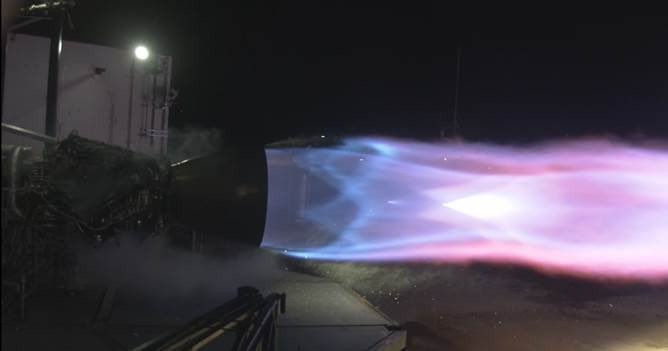According to Elon Musk, SpaceX’s Starship Hopper just completed its inaugural hop test at the company’s South Texas Launch Site. As the first of many, this test is intended to validate the sophisticated Raptor engines that will be used aboard the full-scale Starship spacecraft, which is intrinsic to Musks’ long-term vision of providing intercontinental flights and making commercial trips to the Moon and Mars.
The news was shared via twitter, where Musk retweeted a post and video from Next Spaceflight creator Michael Baylor and twitter user LabPadre. Baylor and LabPadre were on hand to witness the test and live-tweeted the event. The video features an 11-second clip where the Starship Hopper, through a haze of fog, can be seen firing its Raptor engines. Baylor then tweeted at 5:58 p.m. PDT (8:58 p.m. EDT):
“HOT FIRE!!! Raptor comes to life at the base of Starhopper as the vehicle performs a tethered hop at SpaceX’s Boca Chica launch facility. This is the first ever firing of a rocket engine at the launch site.”
Musk followed this up a half hour later by indicating what they had witnessed was a successful tethered hop test. And while this was a baby-step along the long road to conducting orbital and interplanetary flights, this test has opened the door to untethered testing and provided further validation for the Raptor engine.
The engine was already riding high after the successful test-firing that took place back in February. Not only was the test successful, it set a new record for combustion chamber pressure, breaking the previous record held by the Soviet-era RD-180 thruster by a 1% margin – 26.89 MPa (3,900 psi) vs. 26.7 MPa (3,870 psi).
During this test, the propellant’s were kept at temperatures just low enough for them to remain in a liquid state. Musk has indicated that when the propellant is kept at cryogenic temperatures, it will boost efficiency by as much as 20%. Now that the Raptor engines have performed as part of an integrated flight vehicle, SpaceX is one step closer to building the full-scale Starship – which will have 31 Raptor engines.
This successful hop test is the culmination of five weeks worth of preparation and integration, which began back in mid-March. This included a series of “wet dress rehearsals” (WDRs) where the vehicle was loaded with propellant and the avionics and plumbing were tested. The last step was to ignite the Raptor engine and see how its cryogenic systems, pressure systems and engine nozzles fared.

It was during this time that a technical issue with the engine’s cryogenic systems forced a delay. Basically, the ground crews discovered that there was a small buildup of ice in the propellant prevalves, which was the result of the liquid oxygen and methane fuel becoming over-pressurized. This came after the Starship Hopper was knocked over by high winds in late January, which damaged the nose cone.
But with the first hop test complete, SpaceX appears to be back on track and is expected to finish construction of a full-scale orbital prototype by this summer (or in early 2020). Musk also hopes that the Starship will be ready to make cargo flights by 2022, the first lunar passenger flight by 2023, and the first crewed flight to Mars by 2024, followed by the construction of Mars Base Alpha by 2028.
More photos and videos of the successful hop test have become available since the news first broke. Here’s a video that is a little more clear, courtesy of NASA Spaceflight member @BocaChicaGal:
Further Reading: Teslarati
Bagikan Berita Ini














0 Response to "The Starhops Have Begun! - Universe Today"
Post a Comment